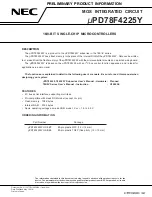
CHAPTER 21:Ethernet MAC
S6J3200 Series Hardware Manual Document Number: 002-04852 Rev. *G
609
3.9.
Energy Efficient Ethernet Support
IEEE Std 802.3az adds support for energy efficiency to Ethernet (EEE). These are the key features of
IEEE Std 802.3az:
1.
Allows a system’s transmit path to enter a low power mode if there is nothing to transmit.
2.
Allows a PHY to detect whether its link partner’s transmit path is in low power mode, therefore
allowing the system’s receive path to enter low power mode.
3.
Link remains up during lower power mode and no frames are dropped.
4.
Asymmetric, one direction can be in low power mode while the other is transmitting normally.
5.
LPI (Low Power idle) signaling is used to control entry and exit to and from low power modes.
6.
LPI signaling can only take place if both sides have indicated support for it through
auto-negotiation.
IEEE Std 802.3az operation:
1.
Low-power control is done at MII (reconciliation sublayer).
2.
As an architectural convenience in writing the 802.3az it is assumed that transmission is
deferred by asserting carrier sense, in practice it will not be done this way. This system will
know when it has nothing to transmit and only enter low power mode when it is not
transmitting.
3.
LPI should not be requested unless the link has been up for at least one second.
4.
LPI is signaled on the MII transmit path by asserting 0x01 on TXD with TX_EN low and TX_ER
high.
5.
A PHY on seeing LPI requested on MII will send the sleep signal before going quiet. After
going quiet it will periodically emit refresh signals.
6.
The sleep, quiet and refresh periods are defined in Table 78-2 of IEEE Std 802.3az. E.g. for
1000BASE-X the sleep period (T
s
) is 20 microseconds, the quiet period (T
q
) is 2.5 milliseconds,
and the refresh period (T
r
) is 20 microseconds.
7.
1000BASE-X is required to go quiet after sleep is signaled. The easiest way to do this is to
write to a control register to disable transmit in the SerDes.
8.
SGMII and XFI are not part of IEEE Std 802.3az and should not go quiet after sleep is
signaled.
9.
LPI mode ends by transmitting normal idle for the wake time. There is a default time for this
but it can be adjusted in software using the Link Layer Discovery Protocol (LLDP) described in
Clause 79 of IEEE Std 802.3az.
10. LPI is indicated at the receive side when sleep and refresh signaling has been detected.
3.10.
LPI Operation in Ethernet MAC
Auto-negotiation:
1.
Indicate EEE capability using auto-negotiation.
For the transmit path:
1.
If the link has been up for 1 second and there is nothing being transmitted, write to the LPI bit
(bit 19) in the Network Control register.
2.
If connected to 1000BASE-T PHY using SGMII or RGMII there is nothing more to do.
3.
If connected to a backplane using a 1000BASE-KX PHY use firmware to periodically disable
the SerDes transmit path. (Write to bit 1.160.0 for 1000BASE-KX.)
Содержание S6J3200 Series
Страница 1041: ...CHAPTER 28 LCD Controller 1040 S6J3200 Series Hardware Manual Document Number 002 04852 Rev G...
Страница 1044: ...CHAPTER 28 LCD Controller S6J3200 Series Hardware Manual Document Number 002 04852 Rev G 1043...
Страница 1047: ...CHAPTER 28 LCD Controller 1046 S6J3200 Series Hardware Manual Document Number 002 04852 Rev G...
Страница 1050: ...CHAPTER 28 LCD Controller S6J3200 Series Hardware Manual Document Number 002 04852 Rev G 1049...
Страница 1084: ...CHAPTER 28 LCD Controller S6J3200 Series Hardware Manual Document Number 002 04852 Rev G 1083...
Страница 1086: ...CHAPTER 28 LCD Controller S6J3200 Series Hardware Manual Document Number 002 04852 Rev G 1085...
Страница 1088: ...CHAPTER 28 LCD Controller S6J3200 Series Hardware Manual Document Number 002 04852 Rev G 1087...















































